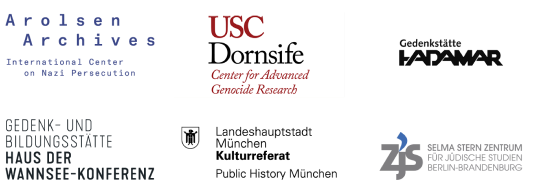Annotations
Lörrach
10/22/1940
Two municipal police officers close the side panel of a truck carrying persecuted people. A security police officer watches them with his hands clasped behind his back, next to him stands another municipal police officer. On the left, girls watch what is happening, at the top of the picture are bystanders on a balcony.
Annotations
Keywords
4
Historical context
Deportation von Lörrach nach Gurs am 22.10.1940
On October 22, 1940, the last day of the Feast of Tabernacles (Sukkot), the municipal and security police deported more than 6,500 Jews from Baden and the region then known as Saar-Palatinate (German: Saarpfalz) to the Gurs internment camp in unoccupied southwestern France. Sixty-two people from Lörrach and the surrounding area persecuted as Jews were arrested by the Gestapo and given two hours to present themselves at the Alte Handelsschule on the market square early in the morning with a maximum of 50 kg of luggage and 100 Reichsmark in cash. After registering them, police officers took them by truck to the assembly point in Freiburg im Breisgau. From there, they travelled on a French passenger train which passed through Mulhouse and Chalon-sur-Saône and took them to Oloron-Sainte-Marie in the Basses-Pyrénées department of France, where they probably arrived on October 25 or 26, 1940. They were taken to Gurs by truck.
Starting in August 1942, the prisoners were deported to Auschwitz via the Drancy assembly camp near Paris. The number of people from Lörrach who survived the Shoah is not known.
About the image series
The picture series from Lörrach includes 25 black-and-white photographs in landscape format, available as digital prints from negative rolls, showing various steps in the deportation process on October 22, 1940. They document the arrival of the Jews by truck at the Alte Handelsschule, where they were registered. Most of the pictures show the persecuted people leaving the building and boarding waiting trucks provided by the municipal police. The series ends with the departure of the trucks from the market square. Officers of the municipal and security police stand guard and supervise the proceedings. In almost all of the images, bystanders observe what is going on at close quarters, sometimes from elevated positions. Five of the persecuted persons in the pictures are known by name.
It was probably police officer Gustav Kühner who took the photos of the deportation on behalf of the Landratsamt (district administration) in Lörrach.
Photographer
Gustav Kühner, police assistant
Gustav Kühner was born in Lörrach on December 18, 1895. In 1920, he joined the police service in his hometown. Nine years later, he transferred to the Lörrach criminal investigations police, where he was trained in how to take photographs for police identification procedures. It is probable that he took pictures of the deportation on October 22, 1940, on behalf of the Landratsamt (district administration) in Lörrach.
Provenance
In 1978, the municipal building authority in Lörrach handed over a small red box labeled "Aufnahmen vor 1945" (photographs taken before 1945) and 15 original negative rolls to Stadtarchiv Lörrach. In addition to local events from the war years, they contained 25 pictures of the deportation to Gurs and 17 pictures of the public auctions of the deportees' household goods in November and December 1940. It is not known how the building authority came to be in possession of the photographs.
The Stadtarchiv initially had prints made, digital copies followed later. It published some pictures in 1988 and showed individual photographs in a local exhibition in 2000. In 2002, Klaus Hesse and Philipp Springer were the first to comment on and contextualize 22 pictures from the two series for the Topography of Terror Foundation. In 2010, the Stadtarchiv showed the pictures of the deportation and the pictures of the auctions together in an exhibition.
Call number at source archive
StaLö 2.29.15
Title at source archive
Ohne Titel
Acknowledgements
Many thanks to Jürgen Schaser and his colleagues at Stadtarchiv Lörrach for providing the images and for their kind support in describing them. Many thanks go to Christiane Walesch-Schneller and Valeska Wilczek from the Blaue Haus in Breisach, who have painstakingly retraced the routes and departure times of the deportation trains.
Text and research by Kerstin Hofmann.
Kooperationsverbund #LastSeen. Bilder der NS-Deportationen Dr. Alina Bothe Projektleiterin
c/o Selma Stern Zentrum für Jüdische Studien Berlin-Brandenburg
Freie Universität Berlin
Habelschwerdter Allee 34A
14195 Berlin
lastseen@zedat.fu-berlin.de
Ein Kooperationsprojekt von

Gefördert durch

Datenschutz | Impressum